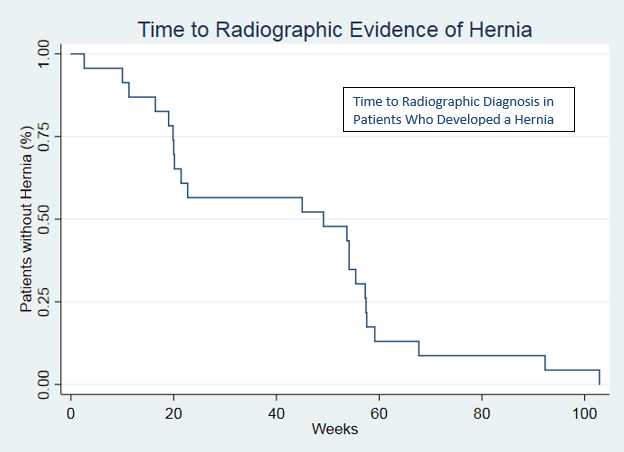Incidence of Fascial Defects at Prior Stoma Sites in Patients with Colorectal Cancer
Jenaya L Goldwag, *Lauren R Wilson, *Srinivas J Ivatury, *Michael J Tsapakos, *Matthew Z Wilson
Dartmouth Hitchcock Medical Center, Lebanon, NH
Objective: Stoma reversal sites are a common location for incisional hernias. We aim to estimate the incidence and risk factors for fascial defects at previous stoma sites in patients with a history of colorectal cancer.
Design: Retrospective cohort study
Setting: An academic tertiary referral center
Patients: Adult patients diagnosed with colorectal cancer, identified by ICD9/10 codes, who underwent stoma reversal, identified by CPT codes, from 2011-2018 and had at least one post-operative CT scan performed.
Main Outcome Measures: Fascial defect identified on post stoma reversal CT scan
Results: Of 92 patents included, 52 (57%) were male, with mean age 58 years at stoma reversal, 81 (87%) were diagnosed with rectal cancer, and 11 (12%) with colon cancer. Fascial defects were noted in 45 (49%) patients, with stoma site hernias containing bowel or intraabdominal fat present in 24 (26%) patients. There were no differences in temporal occurrence of defect development, either posterior defect or hernia, after stoma reversal (p=0.133). Posterior sheath defects were not associated with subsequent hernia development and most hernias occurred within two years. BMI >30 was associated with significantly increased risk of stoma site hernia on multivariate analyses (OR 11.9, 95% CI 2.41-58.94, p=0.002), but smoking, hypertension, stoma type, pathologic stage, and chemotherapy within 90 days were not found to be significant.
Conclusions: The incidence of stoma site hernias is high. Obesity appears to be a significant risk factor for development of these hernias and most hernias occur quickly following surgery. 
Back to 2019 Posters




